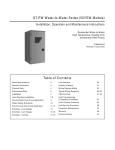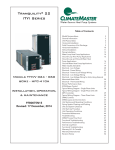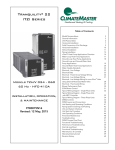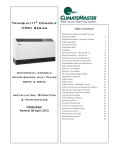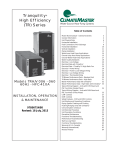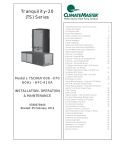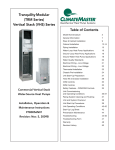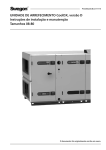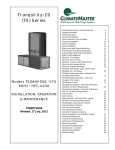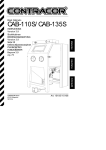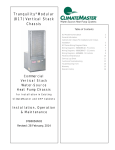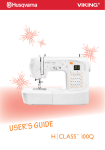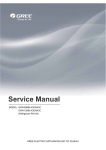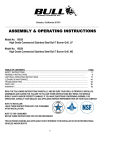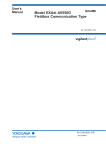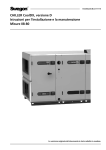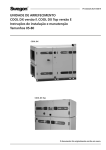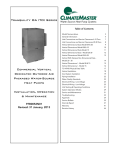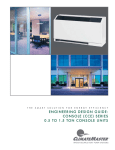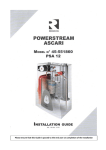Download Tranquility® Water-to-Water (THW) Series
Transcript
Tranquility® Water-to-Water (THW) Series Table of Contents Residential High Temperature Water-to-Water Geothermal Heat Pumps (Heating Only) - 50Hz Installation, Operation & Maintenance 97B0063N04 Revised: 02 January, 2013 Model Nomenclature General Information Physical Data Dimensional Data Installation Load Plumbing Installation Ground-Water Heat Pump Application Water Quality Standards Ground-Loop Heat Pump Application Electrical - Line Voltage Electrical - Low Voltage Electrical - Controls User Interface Installer Interface Wiring Diagram Matrix Typical Wiring Diagrams CXM Controls Unit Commissioning & Operating Conditions Unit & System Checkout Unit Start-Up Procedure Preventive Maintenance Warranty Revision History 3 4 5 6 7 7 9 10 11 13 15 17 20 21 22 23 31 33 34 35 36 37 38 CLIMATEMASTER WATER-SOURCE HEAT PUMPS Tr a n q u i l i t y ® W a t e r- t o - W a t e r T H W S e r i e s R e v i s e d : 0 2 J a n u a r y, 2 0 1 3 This Page Intentionally Left Blank 2 C l i m a t e M a s t e r W a t e r- S o u r c e H e a t P u m p s THE SMART SOLUTION FOR ENERGY EFFICIENCY Tr a n q u i l i t y ® W a t e r- t o - W a t e r T H W S e r i e s R e v i s e d : 0 2 J a n u a r y, 2 0 1 3 Model Nomenclature 1 2 3 4 5 6 7 8 9 10 11 12 13 14 15 T H W 008 A T Q 0 0 C S A S S = Standard Model Type TH = Tranquility High Temperature Heating Only Hydronic Options A = None B = Load Pump W/Expansion Tank C = Load Pump & Source Pump(S) W/Expansion Tanks Configuration W = Water-To-Water Paint Options Unit Size S = Stainless Steel & Pewter (Black) 008 010 012 Source & Load Water Coil Options C = Copper Source & Braze Plate Load N = Cupro-nickel Source & Braze Plate Load Revision Level A = Current Domestic Hot Water Heating Options 0 = None 1 = 3-Way Valve Voltage T = 200-220/50/1 (THW008-010 Only) S = 380-420/50/3 (THW012 Only) Cabinet Insulation Controls 0 = Residential Standard w/UltraQuiet Q = Standard V = Standard With VSFP Safety Warnings, cautions, and notices appear throughout this manual. Read these items carefully before attempting any installation, service, or troubleshooting of the equipment. DANGER: Indicates an immediate hazardous situation, which if not avoided will result in death or serious injury. DANGER labels on unit access panels must be observed. WARNING! WARNING! Units are shipped with R-410A (EarthPure®) refrigerant. The EarthPure® Application and Service Manual should be read and understood before attempting to service refrigerant circuits with R-410A. WARNING! WARNING! To avoid the release of refrigerant into the atmosphere, the refrigerant circuit of this unit must be serviced only by technicians who meet local, state, and federal proficiency requirements. WARNING: Indicates a potentially hazardous situation, which if not avoided could result in death or serious injury. CAUTION: Indicates a potentially hazardous situation or an unsafe practice, which if not avoided could result in minor or moderate injury or product or property damage. NOTICE: Notification of installation, operation, or maintenance information, which is important, but which is not hazard-related. WARNING! WARNING! All refrigerant discharged from this unit must be recovered WITHOUT EXCEPTION. Technicians must follow industry accepted guidelines and all local, state, and federal statutes for the recovery and disposal of refrigerants. If a compressor is removed from this unit, refrigerant circuit oil will remain in the compressor. To avoid leakage of compressor oil, refrigerant lines of the compressor must be sealed after it is removed. c l i m a t e m a s t e r. c o m 3 CLIMATEMASTER WATER-SOURCE HEAT PUMPS Tr a n q u i l i t y ® W a t e r- t o - W a t e r T H W S e r i e s R e v i s e d : 0 2 J a n u a r y, 2 0 1 3 General Information Inspection Upon receipt of the equipment, carefully check the shipment against the bill of lading. Make sure all units have been received. Inspect the carton or crating of each unit, and inspect each unit for damage. Assure the carrier makes proper notation of any shortages or damage on all copies of the freight bill and completes a common carrier inspection report. Concealed damage not discovered during unloading must be reported to the carrier within 15 days of receipt of shipment. If not filed within 15 days, the freight company can deny the claim without recourse. Note: It is the responsibility of the purchaser to file all necessary claims with the carrier. Notify the ClimateMaster Traffic Department of all damage within fifteen (15) days of shipment. Storage Equipment should be stored in its shipping carton in a clean, dry area. Store units in an upright position at all times. Stack units a maximum of 3 units high. CAUTION! CAUTION! DO NOT store or install units in corrosive environments or in locations subject to temperature or humidity extremes (e.g., attics, garages, rooftops, etc.). Corrosive conditions and high temperature or humidity can significantly reduce performance, reliability, and service life. Always move and store units in an upright position. Tilting units on their sides may cause equipment damage. CAUTION! CAUTION! CUT HAZARD - Failure to follow this caution may result in personal injury. Sheet metal parts may have sharp edges or burrs. Use care and wear appropriate protective clothing, safety glasses and gloves when handling parts and servicing heat pumps. Unit Protection Cover units on the job site with either shipping cartons, vinyl film, or an equivalent protective covering. Cap the open ends of pipes stored on the job site. In areas where painting, plastering, and/or spraying has not been completed, all due precautions must be taken to avoid physical damage to the units and contamination by foreign material. Physical damage and contamination may prevent proper start-up and may result in costly equipment clean-up. Examine all pipes, fittings, and valves before installing any of the system components. Remove any dirt or trash found in or on these components. Pre-Installation Installation, Operation, and Maintenance instructions are provided with each unit.. The installation site chosen should include adequate service clearance around the unit. Before unit start-up, read all manuals and become familiar with the unit and its operation. Thoroughly check the system before operation. Prepare units for installation as follows: 1. Compare the electrical data on the unit nameplate with ordering and shipping information to verify that the correct unit has been shipped. 2. Keep the cabinet covered with the shipping carton until installation is complete and all plastering, painting, etc. is finished. 3. Verify refrigerant tubing is free of kinks or dents and that it does not touch other unit components. 4. Inspect all electrical connections. Connections must be clean and tight at the terminals. 5. Locate and verify any HWG or other accessory sensors located in the compressor section. 4 C l i m a t e M a s t e r W a t e r- S o u r c e H e a t P u m p s THE SMART SOLUTION FOR ENERGY EFFICIENCY Tr a n q u i l i t y ® W a t e r- t o - W a t e r T H W S e r i e s R e v i s e d : 0 2 J a n u a r y, 2 0 1 3 Physical Data Model 008 Compressor (qty) Factory Charge HFC-410A (kg) 010 012 Scroll (1) 2.51 2.50 2.84 1 1 1 1 1 1 1 Weight - Operating, (kg) 207 207 234 Weight - Packaged, (kg) 214 214 241 Indoor/Load Water Connection Size FPT (in) 1 Outdoor/Source Water Connection Size FPT (in) 1 Domestic Hot Water Connection Size FPT (in) Dual isolation compressor mounting Balanced Port Expansion Valve (TXV) Insulated Source and Load Water Coils FPT - Female Pipe Thread Maximum Working Pressure (Water Side) Base Unit (kPa) 2068 2068 2068 DHW Option (kPa) 2068 2068 2068 Internal Source Pump w/Expansion Tank (kPa) 310 310 310 Internal Load Pump w/Expansion Tank (kPa) 310 310 310 c l i m a t e m a s t e r. c o m 5 CLIMATEMASTER WATER-SOURCE HEAT PUMPS Tr a n q u i l i t y ® W a t e r- t o - W a t e r T H W S e r i e s R e v i s e d : 0 2 J a n u a r y, 2 0 1 3 Dimensional Data Notes: 1. Front, Side, and Top access is preferred for service access. However, all components may be serviced from the front and Top access panels if side access is not available. 2. While clear access to all removable panels is not required, installer should take care to comply with all building codes and allow adequate clearance for future field service. 1.9” 4.9[4.9cm] cm 5.3[5.3cm] cm 2.1” Water Connections Overall Cabinet 1 Model 6 A Depth B Width C Height 2 D E Source Source (Outdoor) (Outdoor) Water In Water Out 3 F Load (Indoor) Water In 4 5 6 Electric Access Plugs G H J K Load DHW DHW Low (Indoor) Return In Water Out Voltage Water Out L Low Voltage M Power Supply 008 cm. 68.1 65.1 124.2 8.6 20.6 56.6 28.7 45.0 36.6 85.3 90.4 96.5 010 cm. 68.1 65.1 124.2 8.6 20.6 56.6 28.7 45.0 36.6 85.3 90.4 96.5 012 cm. 68.1 65.1 124.2 8.6 20.6 56.6 28.7 45.0 36.6 85.3 90.4 96.5 C l i m a t e M a s t e r W a t e r- S o u r c e H e a t P u m p s THE SMART SOLUTION FOR ENERGY EFFICIENCY Tr a n q u i l i t y ® W a t e r- t o - W a t e r T H W S e r i e s R e v i s e d : 0 2 J a n u a r y, 2 0 1 3 Installation THW Unit Location These units are not designed for outdoor installation. Locate the unit in an INDOOR area that allows enough space for service personnel to perform typical maintenance or repairs. The installation of water source heat pump units and all associated components, parts and accessories which make up the installation shall be in accordance with the regulations of ALL authorities having jurisdiction and MUST conform to all applicable codes. It is the responsibility of the Installing Contractor to determine and comply with ALL applicable codes and regulations. Locate the unit in an indoor area that allows easy removal of access panels, and has enough space for service personnel to perform maintenance or repair. Provide sufficient room to make water and electrical connections. Any access panel screws that would be difficult to remove after the unit is installed should be removed prior to setting the unit. These units are not approved for outdoor installation and, therefore, must be installed inside the structure being conditioned. Do not locate in areas where ambient conditions are not maintained within 4-38°C and up to 75% relative humidity. Load Piping Connections Load piping connections are designated ‘Load Water In and Out’ for the radiant heating system piping, and ‘DHW Water In and Out’ (optional) for connection to the domestic hot water piping. Any unused piping connections on the load side of the THW unit will allow spillage of the load circuit fluid, as the radiant and DHW circuits are connected internally. If a unit is ordered with the DHW option and is not being connected to a radiant heating system, the ‘Load Water In and Out’ (radiant heating circuit) connections must be connected to the ‘DHW In and Out’ piping using tees as shown in Figure 1a. Failure to do so will lead to nuisance high-pressure faults. Load Plumbing Installation THW Unit Load Plumbing The applications are too varied to describe in this document, however some basic guidelines will be presented. All plumbing should conform to local codes and consider the following: Wide temperature variation applications such as heating/cooling coils - Employ piping materials that are rated for the maximum temperature and pressure combination. This excludes PVC for most heating applications. - Insure load water flow in high temperature heating applications is at least 3.2 l/m per kW to improve performance and reduce nuisance high pressure faults. - DO NOT employ plastic to metal threaded joints - Utilize a pressure tank and air separator vent system to equalize pressure and remove air. Swimming Pool Hot Tub Applications - Recommended application includes a brazed plate heat exchanger to isolate pool water from the unit heat exchanger. Potable Water Applications - Insure load water flow in high temperature heating applications is at least 3.2 l/m per kW to improve performance and reduce nuisance high pressure faults. - A secondary heat exchanger must always be used between the water-to-water heat pump and potable water tank. Either an indirect water heat or brazed plate heat exchanger (with a secondary pump) will isolate the potable water from the heating water. Figure 1a: THW DHW Only Piping 7R '+: 6WRUDJH 7DQN ,1 +7* ,1 287 '+: +7* 287 '+: 0 /RDG+; EU]SOW c l i m a t e m a s t e r. c o m 7 CLIMATEMASTER WATER-SOURCE HEAT PUMPS Tr a n q u i l i t y ® W a t e r- t o - W a t e r T H W S e r i e s R e v i s e d : 0 2 J a n u a r y, 2 0 1 3 Load Plumbing Installation Figure 1b: THW Typical Load Piping 359 + & ,QGLUHFW :DWHU+HDWHU $LU9HQW 1RWH )RUV\VWHPVWKDWGRQRWLQFOXGH RSWLRQDOIDFWRU\LQVWDOOHGH[SWDQN ([S 7DQN 7KHUPLVWRU 1RWH 7R)URP 5DGLDQW)ORRU 5DGLDWRU %DVHERDUG RU)DQ&RLO +HDWLQJ6\VWHP + ,1 +7* & ,1 287 '+: +7* 287 '+: 0 +HDWLQJ %XIIHU7DQN 7+: 8QLW 7KHUPLVWRU 1RWH 8 /RDG+; EU]SOW C l i m a t e M a s t e r W a t e r- S o u r c e H e a t P u m p s 127(6 3ODFHDLUYHQWDWWKHKLJKHVWSRLQWLQWKHV\VWHP 7KHUPLVWRUVVKRXOGEHLQVWDOOHGLQDQLPPHUVLRQZHOO /RFDWHWKHUPLVWRULQWKHERWWRPKDOIRIWKHWDQN 37SUHVVXUHWHPSHUDWXUHSRUWVDUHLQWHUQDOIRU7+: XQLWVRQORDGDQGVRXUFHFRQQHFWLRQV 2WKHUFRPSRQHQWVDGGLWLRQDOEDOOYDOYHVXQLRQVHWF PD\EHUHTXLUHGIRUHDVHRIVHUYLFH7KLVGUDZLQJ VKRZVRQO\PLQLPXPUHTXLUHPHQWV<RXUVSHFLILF LQVWDOODWLRQZLOOGLFWDWHILQDOFRPSRQHQWVHOHFWLRQV %XIIHUWDQNPXVWEHDSSURYHGDVDKHDWLQJYHVVHO /RFDOFRGHVXSHUFHGHVDQ\SLSLQJDUUDQJHPHQWVRU FRPSRQHQWVVKRZQRQWKLVGUDZLQJ THE SMART SOLUTION FOR ENERGY EFFICIENCY Tr a n q u i l i t y ® W a t e r- t o - W a t e r T H W S e r i e s R e v i s e d : 0 2 J a n u a r y, 2 0 1 3 Ground-Water Heat Pump Systems Typical open loop piping is shown in Figure 2. Shut off valves should be included in case of servicing. Boiler drains or other valves should be ‘tee’d’ into the line to allow acid flushing of just the heat exchanger. Pressure temperature plugs should be used so that flow and temperature can be measured. Piping materials should be limited to PVC SCH80 or copper. Due to the pressure and temperature extremes, PVC SCH40 is not recommended. Water quantity should be plentiful and of good quality. Consult Table 2 for water quality guidelines. The unit can be ordered with either a copper or cupro-nickel water heat exchanger. Copper is recommended for closed loop systems and open loop ground water systems that are not high in mineral content or corrosiveness. In conditions anticipating heavy scale formation or in brackish water, a cupro-nickel heat exchanger is recommended. In ground water situations where scaling could be heavy or where biological growth such as iron bacteria will be present, a closed loop system is recommended. Heat exchanger coils may over time lose heat exchange capabilities due to a build up of mineral deposits inside. These can be cleaned only by a qualified service mechanic as acid and special pumping equipment are required. Expansion Tank and Pump Use a closed, bladder-type expansion tank to minimize mineral formation due to air exposure. The expansion tank should be sized to handle at least one minute run time of the pump to prevent premature pump failure using its drawdown capacity rating. The pump should be sized to the home’s domestic water load 19-34 l/m plus the heat pump water load. Discharge water from the unit is not contaminated in any manner and can be disposed of in various ways depending on local building codes; i.e. recharge well, storm sewer, drain field, adjacent stream or pond, etc. Most local codes forbid the use of sanitary sewer for disposal. Consult your local building and zoning department to assure compliance in your area. Flow Regulation Flow regulation can be accomplished by two methods. First, most water control valves have a built in flow adjustment. By measuring the pressure drop through the unit heat exchanger, flow rate can be determined and compared to Table 8. Simply adjust the water control valve until the desired flow is achieved. Secondly, a flow control device may be installed. The devices are typically an orifice of plastic material that is designed to allow a specified flow rate. These are mounted on the outlet of the water control valve. On occasion, these valves can produce a velocity noise that can be reduced by applying some back pressure. This is accomplished by slightly closing the leaving isolation valve of the well water setup. Low Temperature Cutout The water low temperature cutout setpoint should be activated to avoid freeze damage to the unit. Consult the low temperature cutout section of the controls description for instructions. CAUTION! CAUTION! Refrigerant pressure activated water regulating valves should never be used with this equipment. Water Control Valve Note the placement of the water control valve. Always maintain water pressure in the heat exchanger by placing water control valves at the outlet of the unit to prevent mineral precipitation. Pilot operated or Taco slow closing valve’s solenoid valves are recommended to reduce water hammer. If water hammer persists, a mini-expansion tank can be mounted on the piping to help absorb the excess hammer shock. Insure that the total ‘VA’ draw of the valve can be supplied by the unit transformer. For instance the Taco slow closing valve can draw up to 35VA. This can overload smaller 40 or 50 VA transformers depending on the other controls employed. A typical pilot operated solenoid valve draws approximately 15VA. Note the special wiring diagram of the AVM valve (Figure 9). c l i m a t e m a s t e r. c o m 9 CLIMATEMASTER WATER-SOURCE HEAT PUMPS Tr a n q u i l i t y ® W a t e r- t o - W a t e r T H W S e r i e s R e v i s e d : 0 2 J a n u a r y, 2 0 1 3 Ground-Water Heat Pump Systems Figure 2: Typical Open Loop/ Well Application Strainer (optional) WARNING! Flow regulator WARNING! Polyolester Oil, commonly known as POE oil, is a synthetic oil used in many refrigeration systems including those with HFC-410A refrigerant. POE oil, if it ever comes in contact with PVC or CPVS piping, may cause failure of the PVC/CPVC. PVC/CPVC piping should never be used as supply or return water piping with water source heat pump products containing HFC-410A as system failures and property damage may result. From pressure tank S To proper discharge location IN Shut-off valve OUT Water control valve High Pressure Switch P/T port Boiler drain (for flushing) THW NOTES: 1. P/T (pressure/temperature) ports are internal for THW series units. 2. Other components (additional ball valves, unions, etc.) may be required for ease of service. This drawing shows only minimum requirements. Your specific installation will dictate final component selections. 3. Local code supercedes any piping arrangements or components shown on this drawing. Source HX (coaxial) Sound absorbing pad Table 2: Water Quality Standards Water Quality Parameter HX Material Closed Recirculating Open Loop and Recirculating Well Scaling Potential - Primary Measurement Above the given limits, scaling is likely to occur. Scaling indexes should be calculated using the limits below pH/Calcium Hardness Method All - pH < 7.5 and Ca Hardness <100ppm Index Limits for Probable Scaling Situations - (Operation outside these limits is not recommended) Scaling indexes should be calculated at 66°C for direct use and HWG applications, and at 32°C for indirect HX use. A monitoring plan should be implemented. Ryznar 6.0 - 7.5 All Stability Index If >7.5 minimize steel pipe use. -0.5 to +0.5 Langelier All If <-0.5 minimize steel pipe use. Based upon 66°C HWG and Saturation Index Direct well, 29°C Indirect Well HX Iron Fouling Iron Fe 2+ (Ferrous) (Bacterial Iron potential) All Iron Fouling All - <0.2 ppm (Ferrous) If Fe2+ (ferrous)>0.2 ppm with pH 6 - 8, O2<5 ppm check for iron bacteria. - <0.5 ppm of Oxygen Above this level deposition will occur . Corrosion Prevention 6 - 8.5 pH All Hydrogen Sulfide (H2S) All Ammonia ion as hydroxide, chloride, nitrate and sulfate compounds All Monitor/treat as needed - 6 - 8.5 Minimize steel pipe below 7 and no open tanks with pH <8 <0.5 ppm At H2S>0.2 ppm, avoid use of copper and copper nickel piping or HX's. Rotten egg smell appears at 0.5 ppm level. Copper alloy (bronze or brass) cast components are OK to <0.5 ppm. - <0.5 ppm Maximum Allowable at maximum water temperature. Maximum Chloride Levels Copper Cupronickel 304 SS 316 SS Titanium - 10$C <20ppm <150 ppm <400 ppm <1000 ppm >1000 ppm 24$C NR NR <250 ppm <550 ppm >550 ppm 38 C NR NR <150 ppm < 375 ppm >375 ppm Erosion and Clogging Particulate Size and Erosion All <10 ppm of particles and a maximum velocity of 1.8 m/s Filtered for maximum 841 micron [0.84 mm, 20 mesh] size. <10 ppm (<1 ppm "sandfree” for reinjection) of particles and a maximum velocity of 1.8 m/s. Filtered for maximum 841 micron 0.84 mm, 20 mesh] size. Any particulate that is not removed can potentially clog components. The ClimateMaster Water Quality Table provides water quality requirements for ClimateMaster coaxial heat exchangers. When water properties are outside of those requirements, an external secondary heat exchanger must be used to isolate the heat pump heat exchanger from the unsuitable water. Failure to do so will void the warranty for the coaxial heat exchanger. Notes: &ORVHG5HFLUFXODWLQJV\VWHPLVLGHQWLILHGE\Dclosed pressurized piping system. 5HFLUFXODWLQJRSHQZHOOVVKRXOGREVHUYHWKHRSHQUHFLUFXODWLQJGHVLJQFRQVLGHUDWLRQV 15Application not recommended. 1RGHVLJQ0D[LPXP 10 C l i m a t e M a s t e r W a t e r- S o u r c e H e a t P u m p s Rev.: 3/22/2012 THE SMART SOLUTION FOR ENERGY EFFICIENCY Tr a n q u i l i t y ® W a t e r- t o - W a t e r T H W S e r i e s R e v i s e d : 0 2 J a n u a r y, 2 0 1 3 Ground-Loop Heat Pump Applications Piping Installation The typical closed loop ground source system is shown in Figure 3. All earth loop piping materials should be limited to only polyethylene fusion in inground sections of the loop. Galvanized or steel fitting should not be used at any time due to their tendency to corrode. All plastic to metal threaded fittings should be avoided due to their potential to leak in earth coupled applications and a flanged fitting substituted. P/T plugs should be used so that flow can be measured using the pressure drop of the unit heat exchanger in lieu of other flow measurement means. Earth loop temperatures can range between -3.9 - 43.3°C. Upon completion of the ground loop piping, pressure test the loop to assure a leak free system. Horizontal Systems: test individual loops as installed. Test entire system when all loops are assembled. Vertical U-Bends and Pond Loop Systems: test vertical U-bends and pond loop assemblies prior to installation with a hydrostatic test pressure of at least 689 kPa. Table 3: Approximate Fluid Volume Fluid Volume (liters per 30 meters Pipe) Pipe Copper Rubber Hose Size Volume (liters) 1” 15.3 1.25” 23.8 2.5” 34.3 1” 14.6 3/4” IPS SDR11 10.4 1” iPS SDR11 16.7 1.25” IPS SDR11 29.8 1.5” IPS SDR11 40.7 2” IPS SDR11 67.0 1.25” IPS SCH40 30.9 1.5” IPS SCH40 40.7 2” IPS SCH40 63.4 Unit Heat Exchanger Typical 3.8 Flush Cart Tank [254mm x 91.4cm tall] 37.9 Polyethylene Flushing the Earth Loop Once piping is completed between the unit, flow center and the ground loop (Figure 3), final purging and charging of the loop is needed. A flush cart (at least a 1.1 kW pump) is needed to achieve adequate flow velocity in the loop to purge air and dirt particles from the loop itself. An antifreeze solution is used in most areas to prevent freezing. All air and debris must be removed from the earth loop piping system before operation. Flush the loop with a high volume of water at a high velocity (0.6 m/s in all piping) both directions. The steps below must be followed for proper flushing. Fill loop with water from a garden hose through flush cart before using flush cart pump to ensure an even fill. Once full, do not allow the water level in the flush cart tank to drop below the pump inlet line or air can be pumped back out to the earth loop. Try to maintain a fluid level in the tank above the return tee so that air can not be continuously mixed back into the fluid. 345 kPa surges can be used to help purge air pockets by simply shutting off the return valve going into the flush cart reservoir. This ‘dead heads’ the pump to 345 kPa. To dead head the pump until maximum pumping pressure is reached, open the valve back up and a pressure surge will be sent through the loop to help purge air pockets from the piping system. Notice the drop in fluid level in the flush cart tank. If air is purged from the system, the level will drop only 25-50mm in a 254mm diameter PVC flush tank since liquids are incompressible. If the level drops more than this, flushing should continue since air is still being compressed in the loop fluid. Do this a number of times. When the fluid level drops less than 25-50mm in a 254mm diameter tank the flow can be reversed. Finally the dead head test should be checked again for an indication of air in the loop. This fluid level drop is your only indication of air in the loop. Table 4: Antifreeze Percentages by Volume Type Minimum Temperature for Low Temperature Protection -12.2°C -9.4°C -6.7°C -3.9°C 25% 38% 29% 21% 25% 25% 16% 22% 20% 10% 15% 14% Methanol 100% USP food grade Propylene Glycol Ethanol* * Must not be denatured with any petroleum based product c l i m a t e m a s t e r. c o m 11 CLIMATEMASTER WATER-SOURCE HEAT PUMPS Tr a n q u i l i t y ® W a t e r- t o - W a t e r T H W S e r i e s R e v i s e d : 0 2 J a n u a r y, 2 0 1 3 Ground-Loop Heat Pump Applications Antifreeze may be added before, during, or after the flushing procedure. However, depending upon which time is chosen, antifreeze could be wasted when emptying the flush cart tank. See antifreeze section for more details. Loop static pressure will fluctuate with the seasons. Pressures will be higher in the winter months than during the cooling season. This fluctuation is normal and should be considered when charging the system initially. Run the unit in either heating or cooling for a number of minutes to condition the loop to a homogenous temperature. This is a good time for tool cleanup, piping insulation etc. Then final flush and pressurize the loop to a static pressure of 275-345 kPa (winter) 100-138 kPa (summer). After pressurization, be sure to remove the plug in the end of the Grundfos loop pump motor(s) to allow trapped air to be discharged and to insure the motor housing has been flooded. This is not required for Taco circulators. Insure the loop flow center provides adequate flow through the unit by checking pressure drop across the heat exchanger and comparing it to the figures shown in Table 8. Figure 3: Typical Earth Loop Connection. Antifreeze In areas where minimum entering loop temperatures drop below 4.4°C or where piping will be routed through areas subject to freezing, antifreeze is needed. Alcohols and glycols are commonly used as antifreezes, however your local territory manager should be consulted for the antifreeze best suited to your area. Freeze protection should be maintained to -9.4°C below the lowest expected entering loop temperature. All alcohols should be premixed and pumped from a reservoir outside of the building when possible or introduced under water level to prevent fuming. Initially calculate the total volume of fluid in the piping system using Table 3. Then use the percentage by volume shown in Table 4 for the amount of antifreeze. Antifreeze concentration should be checked from a well mixed sample using a hydrometer to measure specific gravity. Low Water Temperature Cut-Out Setting When an antifreeze is selected the low temperature limit setpoint should be switched to the lower setting to avoid nuisance faults. Consult Low Water Temperature Cut-Out Setting in the controls section for more information. 7R)URP*URXQG/RRS WARNING! 2SWLRQDO)ORZ&RQWUROOHU IRUXQLWVQRWHTXLSSHG ZLWKDQLQWHUQDOSXPS )ORZ&RQWUROOHU WARNING! Polyolester Oil, commonly known as POE oil, is a synthetic oil used in many refrigeration systems including those with HFC-410A refrigerant. POE oil, if it ever comes in contact with PVC or CPVS piping, may cause failure of the PVC/CPVC. PVC/CPVC piping should never be used as supply or return water piping with water source heat pump products containing HFC-410A as system failures and property damage may result. 37SRUW ,1 7+: 287 127(6 37SUHVVXUHWHPSHUDWXUHSRUWVDUHLQWHUQDOIRU7+: VHULHVXQLWV 6RXUFHZDWHUSLSLQJPXVWEHLQVXODWHGIRUFORVHGORRS LQVWDOODWLRQV 2WKHUFRPSRQHQWVDGGLWLRQDOEDOOYDOYHVXQLRQVHWF PD\EHUHTXLUHGIRUHDVHRIVHUYLFH7KLVGUDZLQJ VKRZVRQO\PLQLPXPUHTXLUHPHQWV<RXUVSHFLILF LQVWDOODWLRQZLOOGLFWDWHILQDOFRPSRQHQWVHOHFWLRQV /RFDOFRGHVXSHUFHGHVDQ\SLSLQJDUUDQJHPHQWVRU FRPSRQHQWVVKRZQRQWKLVGUDZLQJ 6RXQGDEVRUELQJSDG 12 C l i m a t e M a s t e r W a t e r- S o u r c e H e a t P u m p s THE SMART SOLUTION FOR ENERGY EFFICIENCY Tr a n q u i l i t y ® W a t e r- t o - W a t e r T H W S e r i e s R e v i s e d : 0 2 J a n u a r y, 2 0 1 3 Electrical - Line Voltage All field installed wiring, including electrical ground, must comply with the National Electrical Code as well as all applicable local codes. WARNING! WARNING! To avoid possible injury or death due to electrical shock, open the power supply disconnect switch and secure it in an open position during installation. Refer to the unit wiring diagrams for fuse sizes and a schematic of the field connections which must be made by the installing (or electrical) contractor. CAUTION! CAUTION! Use only copper conductors for field installed electrical wiring. Unit terminals are not designed to accept other types of conductors. Consult the unit wiring diagram located on the inside of the compressor access panel to ensure proper electrical hookup. All final electrical connections must be made with a length of flexible conduit to minimize vibration and sound transmission to the building. General Line Voltage Wiring Be sure the available power is the same voltage and phase as that shown on the unit serial plate. Line and low voltage wiring must be done in accordance with local codes or the National Electric Code, whichever is applicable. Control Transformer (Dual Voltage) Confirm that power supply and transformer are compatible and switch wiring as necessary. THW Power Connection Line voltage connection is made by connecting the incoming line voltage wires to the power block as shown in Figure 5. Consult Table 5 for correct fuse size. Table 5: Electrical Data Model Voltage Code Voltage Min/Max Voltage Compressor Qty RLA LRA Load Pump FLA - T 200-220/50/1 190/242 1 18.9 94 THW008 S T 380-420/50/3 200-220/50/1 361/462 190/242 1 1 6.6 24.7 39 121 THW010 S THW012 S 380-420/50/3 380-420/50/3 361/462 361/462 1 1 7.9 9.8 41 70 Source Source Pump (1) Pump (2) FLA FLA - - Total Unit FLA Min Circuit Amps Max Fuse HACR 18.9 23.6 40 0.8 - - 19.7 24.4 40 0.8 0.8 - 20.5 25.2 40 - - - 6.6 8.3 15 0.8 - - 7.4 9.1 15 0.8 0.8 - 8.2 9.9 15 - - - 24.7 30.9 50 0.8 - - 25.5 31.7 50 0.8 0.8 0.8 27.1 33.3 50 - - - 7.9 9.9 15 0.8 - - 8.7 10.7 15 0.8 0.8 0.8 10.3 12.3 20 - - - 9.8 12.3 20 1.07 - - 10.9 13.3 20 1.07 1.07 1.07 13 15.5 25 c l i m a t e m a s t e r. c o m 13 CLIMATEMASTER WATER-SOURCE HEAT PUMPS Tr a n q u i l i t y ® W a t e r- t o - W a t e r T H W S e r i e s R e v i s e d : 0 2 J a n u a r y, 2 0 1 3 Electrical - Line Voltage Figure 4: THW 50Hz Line and Low Voltage Field Low Voltage Wiring 14 Field Line Voltage Wiring C l i m a t e M a s t e r W a t e r- S o u r c e H e a t P u m p s THE SMART SOLUTION FOR ENERGY EFFICIENCY Tr a n q u i l i t y ® W a t e r- t o - W a t e r T H W S e r i e s R e v i s e d : 0 2 J a n u a r y, 2 0 1 3 Electrical - Low Voltage Low Voltage Connections The thermistors (sensors) and other low voltage wiring should be connected to the 12 position terminal strip in the THW control box. See figure 4 and unit wiring diagram for details. Low Water Temperature Cutout - FP1 The CXM/DXM control allows the field selection of source fluid low temperature cutout points. The factory setting of FP1 is set for water -1.1°C. In cold temperature applications jumper JW3 (FP1- antifreeze -12.2°C) should be clipped as shown in Figure 6 to change the setting to -12.2°C, a more suitable temperature when using antifreezes. "A" has been provided to control accessory devices, such as water valves, electronic air cleaners, humidifiers, etc. Note: This terminal should be used only with 24 Volt signals and not line voltage signals. This signal operates with the compressor contactor. See Figure 7 or the wiring schematic for details. Figure 7: Accessory Wiring Accessory Connections A terminal paralleling the compressor contactor coil has been provided on the CXM/DXM control of the THW unit. Figure 6: Changing FP1-Low Water Temperature Cutout Setpoint JW3-FP1 jumper should be clipped when antifreeze is used. CXM Board Water Solenoid Valves Figures 8 and 9 illustrate a typical slow closing water control valve wiring. A slow closing valve may be required to prevent water hammer. When using an AVMB -Taco Slow Closing valves on THW Series equipment Figure 9a wiring should be utilized. The valve takes approximately 60 seconds to open (very little water will flow before 45 seconds) and it activates the compressor only after the valve is completely opened (by closing its end switch). Only relay or triac based electronic thermostats should be used with the AVMB valve. When wired as shown, the valve will operate properly with the following notations: 1. The valve will remain open during a unit lockout. 2. The valve will draw approximately 25-35 VA through the “Y” signal of the thermostat. c l i m a t e m a s t e r. c o m 15 CLIMATEMASTER WATER-SOURCE HEAT PUMPS Tr a n q u i l i t y ® W a t e r- t o - W a t e r T H W S e r i e s R e v i s e d : 0 2 J a n u a r y, 2 0 1 3 Electrical - Low Voltage Figure 8: Well Water AVMB Valve Wiring CAUTION! CXM Board* Y R 2 1 Heater CAUTION! Refrigerant pressure activated water regulating valves should never be used with this equipment. 3 Switch AVMB Taco Valve Y1 MPC* *Valve must be wired in between the CXM and MPC boards. Remove the yellow wire from the CXM board and connect it to terminal 2 on the valve. Add a new wire from terminal 3 to the Y terminal at the CXM board, and a jumper wire from terminal 1 to terminal R at the CXM board as shown above. Figure 9: Taco SBV Valve Wiring C Y1 Y* MPC* CXM Board Taco SBV Valve *Valve must be wired in between the CXM and MPC boards. Remove the yellow wire from the CXM board and connect it to the w/y terminal on the valve. Add a new wire from the end switch (bottom connection) to the the Y terminal at the CXM board, and a jumper wire from the w/y terminal to the other side (top connection) of the end switch as shown above. 16 C l i m a t e M a s t e r W a t e r- S o u r c e H e a t P u m p s THE SMART SOLUTION FOR ENERGY EFFICIENCY Tr a n q u i l i t y ® W a t e r- t o - W a t e r T H W S e r i e s R e v i s e d : 0 2 J a n u a r y, 2 0 1 3 Electrical - Controls Controls User interface: Figure 8 shows the factory installed and wired panel-mounted user interface for customizing the MPC programming. A large dot-matrix style 2” x 2” [5 x 5 cm] back-lit display is controlled by four arrow keys and a select key. The main screen, as shown in figure 9, displays current outdoor and water temperatures, and allows the user to change settings by selecting one of the menus from the bottom of the screen (see figure 11 THW User Interface Menu). A special installer set up mode allows the technician to change some of the default MPC parameters. The installer menu may only be accessed when the unit is placed in the off mode. Holding the up and down buttons at the same time will cause the interface to enter the installer setup mode. See figure 12 (interface installer menu) The user interface includes a time schedule for DHW generation, Fahrenheit/Celsius selection, vacation mode for DHW, and other user preference options. Figure 8: THW User Interface Arrow Keys Select Key Figure 9: THW User Interface Main Screen 6(37 THW Series Control Features The advantage of a programmable controller, as outlined above, is the ability to integrate complex decision-making tasks with the standard heat pump (CXM) controls and communicate with a user interface. Below is a list of standard features that are included in the THW series controls. CAUTION! CAUTION: Maximum leaving water temperature of the THW series equipment is 63°C. For domestic hot water tank temperatures or heating buffer tank temperatures above 54°C, pump and pipe sizing is critical to insure that the flow rate through the heat pump is sufficient to maintain leaving water temperatures below the maximum temperature, and to provide water flow rates within the ranges shown in the performance section of this manual. Outdoor temperature reset: The heat pump capacity and water temperature delivery to the heating system must be designed for local weather conditions, usually at the 99.6% outdoor temperature. Therefore, 99.6% of the heating season, the heating load is less than it is at design conditions. As the outdoor temperature decreases, the heat loss of the structure increases, which requires more capacity from the heating system. If the water temperature is reduced as the outdoor air temperature increases (and vise-versa), the heat pump operates at higher COP most of the year. The MPC has a built in algorithm that adjusts the buffer tank temperature based upon outdoor air temperature to maximize efficiency and comfort. Temperature settings may be adjusted at the user interface if factory defaults are not sufficient. The base setpoint for energizing the compressor in the heating mode is determined by subtracting one-half the heating differential value (HTD) from the buffer tank heating temperature setpoint. The HTD is the differential used for controlling setpoint. For example, if the buffer tank setpoint is 38°C, and the HTD is 3°C, the compressor will be energized at 36°C and will be turned off at 39°C. The HTD is the difference between the compressor “call” 36°C and the “satisfied” 39°C temperature. The buffer tank temperature may then be reduced by the outdoor temperature reset function, depending on the current outdoor air temperature (OAT) value. The valid range for the buffer tank heating setpoint is 21-60°C, with a default value of 38°C. The valid range for the heating differential value is 2-11°C, adjustable in 1°C increments, with a default value of 3°C. c l i m a t e m a s t e r. c o m 17 CLIMATEMASTER WATER-SOURCE HEAT PUMPS Tr a n q u i l i t y ® W a t e r- t o - W a t e r T H W S e r i e s R e v i s e d : 0 2 J a n u a r y, 2 0 1 3 Electrical - Controls There are four outdoor reset variables used for reducing the buffer tank setpoint. The outdoor design temperature (ODT) is the OAT above which setpoint reduction begins. The valid range for ODT is -40°C to 10°C, with a default value of -18°C. The maximum design buffer tank temperature (MaxBT) is the maximum desired buffer tank setpoint at the outdoor design temperature. The valid range for MaxBT is 27-60°C, with a default value of 54°C. The building balance point temperature (the temperature at which heating is no longer needed) is the OAT at which maximum setpoint (MaxBT) reduction will occur. The valid range for building balance point is 10-21°C, with a default value of 16°C. The minimum design water temperature is the minimum desired buffer tank Table 6: Buffer Tank Interface Inputs Setting Description Range Default Buffer Tank Set Point 21-60°C 38°C Buffer Tank Deadband 2-11°C 3°C Outdoor Design Temp -40-10°C -18°C Maximum Design Water Temp 27-60°C 54°C Minimum Design Water Temp 21-49°C 21°C Building Balance Point Temp 10-21°C 16°C The maximum design water temperature must be equal the buffer tank setpoint. The buffer tank setpoint will override the maximum design temperature if they are entered with different values. setpoint at the building balance point temperature. The valid range for minimum buffer tank temperature is 21-49°C, with a default value of 21°C. If an OAT sensor is not detected (or if a thermistor error has occurred), the buffer tank setpoint will not be reduced based on the OAT value (i.e. the controller will use the buffer tank setpoint as described in the previous paragraph). Figure 11 shows an example outdoor temperature reset curve for a climate that has an outdoor design temperature of -20°C. At design temperature, the radiant floor system needs 52°C water. However, when the outdoor temperature is 20°C, the home needs no heating (building balance point). In between -20°C and 20°C, the water temperature in the buffer tank is adjusted accordingly. For homes that are well insulated and tightly sealed, the building balance point may be 13°C or lower, so the slope of the line changes based upon settings at the user interface. The radiant floor design temperature will also change the slope of the line. If tighter pipe spacing is used, for example, the water temperature at the outdoor design temperature may only be 38°C. Again, as the settings are changed at the user interface, the slope of the line will change. As mentioned earlier, the lower the heating water temperature at design conditions, the higher the efficiency (COP) of the heat pump. The combination of a lower design temperature and outdoor temperature reset can result in a significant impact on operating costs. Figure 11: Example Outdoor Temperature Reset Buffer Tank Temperature, °C 55 52°C 50 45 40 35 30 Maximum Buffer Tank Temperature Minimum Buffer Tank Temperature 25 20 20°C 15 10 30 25 20 Outdoor Design Temperature Building Balance Point Temperature 15 10 5 0 -5 -10 -15 Outdoor Temperature, °C 18 C l i m a t e M a s t e r W a t e r- S o u r c e H e a t P u m p s -20 -25 -30 THE SMART SOLUTION FOR ENERGY EFFICIENCY Tr a n q u i l i t y ® W a t e r- t o - W a t e r T H W S e r i e s R e v i s e d : 0 2 J a n u a r y, 2 0 1 3 Electrical - Controls Warm weather shutdown (WWSD): Radiant floor systems are the most comfortable type of heating available today. However, they do have one disadvantage – quickly switching from heating to cooling is not possible due to the mass heat storage in the slab. For example, in the spring or fall, there could be times where heating is required at night, but cooling is required during the day. With a warm floor, the cooling system has to work much harder to cool the space. WWSD shuts down the water-to-water heat pump at a pre-determined outdoor air temperature (adjustable at the user interface). When a water-to-air heat pump is used for space cooling, this unit can be enabled when WWSD is activate, allowing the water-to-air heat pump to heat via forced air during the shoulder seasons, avoiding the warm slab/cooling dilemma (see cooling enable, below). A normally closed contact is provided in the THW unit to de-energize the heating system controls (e.g. radiant floor control panel) during WWSD. WWSD does not affect DHW heating. In other words, the water-to-water unit can still operate for generating DHW, even if the heating distribution (e.g. radiant floor) system is disabled. Second stage heating (backup boiler): Optimal heat pump sizing may not include a water-to-water heat pump that can handle 100% of the heating load. When a backup boiler is used to supplement the heating capacity, a 24VAC output from the THW unit can energize the boiler. The boiler control box simply needs a relay that can be used to interface with the THW unit. The WWSD activation (i.e. when the WWSD feature is enabled) outdoor air temperature range is 4-38°C with a default value of 21°C. The WWSD deactivation (i.e. when the radiant heating returns to operating mode) temperature range is 2-35°C with a default value of 18°C and a minimum difference between activation and deactivation temperatures of 3°C. If the outdoor air temperature (OAT) rises above the activation temperature, the cooling enable signal (see below) is enabled, and the control no longer controls the buffer tank temperature. If the OAT falls below the deactivation temperature, the control resumes monitoring the buffer tank temperature. Emergency DHW generation: If the THW unit is locked out, a 24VAC signal can be sent to a contactor at the water heater to allow the operation of the electric elements and associated thermostat. Cooling enable: Cooling enable is tied to the WWSD feature. If desired, the water-to-air unit controls can be wired to the THW unit controls, which will allow the water-to-air unit to operate during WWSD, but will disable the water-to-air unit when the THW unit is not in WWSD mode. When a heat pump thermostat is connected to the water-to-air unit, forced air heating may be used for the shoulder seasons, allowing quick heating to cooling changeover. If this feature is used, the consumer will easily be able to tell when WWSD is enabled because the water-to-air unit thermostat will only be active during WWSD. Otherwise, the waterto-air unit thermostat will be disabled, indicating that the consumer should utilize the hydronic heating (e.g. radiant floor) thermostat. DHW priority: By default, DHW heating always takes priority over space heating. Normally, the hot water load will be satisfied quickly, and the unit can then switch back to space heating. Time schedule: DHW temperatures may be adjusted during occupied/unoccupied times via the user interface to save energy costs. Vacation mode: DHW generation may be disabled when the user interface is placed in vacation mode. A return date and time may be set to restore normal DHW temperatures. Enhanced heat pump lockouts: Like any ClimateMaster unit, the CXM board locks out the compressor any time a lockout condition occurs. The MPC reads the lockouts from the CXM, and reports the condition to the user interface. The user interface changes from a blue backlight to a red backlight, indicating a lockout. The actual lockout is reported (e.g. High Pressure) at the interface. In addition to the standard CXM faults, the MPC checks for bad thermistors and high compressor discharge temperature, which are also reported at the user interface. Pump control: If the optional load and source pump(s) are selected, the control energizes the pumps any time the compressor is operating. Variable speed floor pump (VSFP) output: Some radiant floor systems utilize a variable speed pump on the floor system, which changes flow based upon the number of zones open or closed. Since the pump has built-in controls, only a power supply is needed. An optional power terminal is available for VSFP applications. c l i m a t e m a s t e r. c o m 19 CLIMATEMASTER WATER-SOURCE HEAT PUMPS Tr a n q u i l i t y ® W a t e r- t o - W a t e r T H W S e r i e s R e v i s e d : 0 2 J a n u a r y, 2 0 1 3 Electrical - Controls Figure 12: THW User Interface Menu SET DATE AND TIME VACATION HOLD DATE THEN TIME MAIN SCREEN PROGRAM MENU MAIN MENU PROGRAM SETTINGS MODE PROGRAM SCREEN DAYLIGHT SAVINGS SET MONTH, DAY, YR, HR, MIN EVENTS PER DAY 2ND STAGE HEAT WM. WEATHER SHUTDOWN F OR C 12 OR 24 HOUR CLOCK SCREEN SETTINGS LANGUAGE CONTRAST TEMPERATURE OFFSETS BACKLIGHT SECURITY LOCKOUT TEMP ADJUST LOCKOUT TOTAL KEYPAD LOCKOUT SERVICE INFORMATION OPERATING MODE 20 C l i m a t e M a s t e r W a t e r- S o u r c e H e a t P u m p s FAULT STATUS TEMPERATURE STATUS CLEAR FAULT HISTORY FAULT DESCRIPTION THE SMART SOLUTION FOR ENERGY EFFICIENCY Tr a n q u i l i t y ® W a t e r- t o - W a t e r T H W S e r i e s R e v i s e d : 0 2 J a n u a r y, 2 0 1 3 Electrical - Controls Figure 13: THW Installer Interface Menu BUFFER TANK SETPOINT BUFFER TANK DEADBAND OUTDOOR TEMPERATURE RESET INSTALLER MENU HOT WATER DEADBAND MANUAL OPERATION OUTDOOR DESIGN TEMP MAXIMUM WATER TEMP MINIMUM WATER TEMP BALANCE POINT TEMP INPUT DEALER INFORMATION RESTORE DEFAULTS c l i m a t e m a s t e r. c o m 21 CLIMATEMASTER WATER-SOURCE HEAT PUMPS Tr a n q u i l i t y ® W a t e r- t o - W a t e r T H W S e r i e s R e v i s e d : 0 2 J a n u a r y, 2 0 1 3 Electrical - Wiring Diagram Matrix 22 Model Diagram Number Voltage THW008/010 96B0108N01 220/50/1 - THW008/010 96B0108N02 220/50/1 VSFP THW008-012 97B0108N03 380-420/50/3 - THW008-012 97B0108N04 380-420/50/3 VSFP Option C l i m a t e M a s t e r W a t e r- S o u r c e H e a t P u m p s THE SMART SOLUTION FOR ENERGY EFFICIENCY Tr a n q u i l i t y ® W a t e r- t o - W a t e r T H W S e r i e s R e v i s e d : 0 2 J a n u a r y, 2 0 1 3 Typical Wiring Diagram - THW 220/50/1 Units c l i m a t e m a s t e r. c o m 23 CLIMATEMASTER WATER-SOURCE HEAT PUMPS Tr a n q u i l i t y ® W a t e r- t o - W a t e r T H W S e r i e s R e v i s e d : 0 2 J a n u a r y, 2 0 1 3 Typical Wiring Diagram - THW 220/50/1 Units 24 C l i m a t e M a s t e r W a t e r- S o u r c e H e a t P u m p s THE SMART SOLUTION FOR ENERGY EFFICIENCY Tr a n q u i l i t y ® W a t e r- t o - W a t e r T H W S e r i e s R e v i s e d : 0 2 J a n u a r y, 2 0 1 3 Typical Wiring Diagram - THW 220/50/1 Units with VSFP c l i m a t e m a s t e r. c o m 25 CLIMATEMASTER WATER-SOURCE HEAT PUMPS Tr a n q u i l i t y ® W a t e r- t o - W a t e r T H W S e r i e s R e v i s e d : 0 2 J a n u a r y, 2 0 1 3 Typical Wiring Diagram - THW 220/50/1 Units with VSFP 26 C l i m a t e M a s t e r W a t e r- S o u r c e H e a t P u m p s THE SMART SOLUTION FOR ENERGY EFFICIENCY Tr a n q u i l i t y ® W a t e r- t o - W a t e r T H W S e r i e s R e v i s e d : 0 2 J a n u a r y, 2 0 1 3 Typical Wiring Diagram - THW 220/50/3 Units c l i m a t e m a s t e r. c o m 27 CLIMATEMASTER WATER-SOURCE HEAT PUMPS Tr a n q u i l i t y ® W a t e r- t o - W a t e r T H W S e r i e s R e v i s e d : 0 2 J a n u a r y, 2 0 1 3 Typical Wiring Diagram - THW 220/50/3 Units 28 C l i m a t e M a s t e r W a t e r- S o u r c e H e a t P u m p s THE SMART SOLUTION FOR ENERGY EFFICIENCY Tr a n q u i l i t y ® W a t e r- t o - W a t e r T H W S e r i e s R e v i s e d : 0 2 J a n u a r y, 2 0 1 3 Typical Wiring Diagram - THW 220/50/3 Units c l i m a t e m a s t e r. c o m 29 CLIMATEMASTER WATER-SOURCE HEAT PUMPS Tr a n q u i l i t y ® W a t e r- t o - W a t e r T H W S e r i e s R e v i s e d : 0 2 J a n u a r y, 2 0 1 3 Typical Wiring Diagram - THW 220/50/3 Units 30 C l i m a t e M a s t e r W a t e r- S o u r c e H e a t P u m p s THE SMART SOLUTION FOR ENERGY EFFICIENCY Tr a n q u i l i t y ® W a t e r- t o - W a t e r T H W S e r i e s R e v i s e d : 0 2 J a n u a r y, 2 0 1 3 CXM Control CXM Control For detailed control information, see CXM Application, Operation and Maintenance (AOM) manual (part # 97B0003N12. for DDC operation. If set to “DDC Output at EH2,” the EH2 terminal will continuously output the last fault code of the controller. If set to “EH2 normal,” EH2 will operate as standard electric heat output. On = EH2 Normal. Off = DDC Output at EH2. Field Selectable Inputs Test mode: Test mode allows the service technician to check the operation of the control in a timely manner. By momentarily shorting the test terminals, the CXM control enters a 20 minute test mode period in which all time delays are sped up 15 times. Upon entering test mode, the status LED will flash a code representing the last fault. For diagnostic ease at the thermostat, the alarm relay will also cycle during test mode. The alarm relay will cycle on and off similar to the status LED to indicate a code representing the last fault, at the thermostat. Test mode can be exited by shorting the test terminals for 3 seconds. Retry Mode: If the control is attempting a retry of a fault, the status LED will slow flash (slow flash = one flash every 2 seconds) to indicate the control is in the process of retrying. Field Configuration Options Note: In the following field configuration options, jumper wires should be clipped ONLY when power is removed from the CXM control. Water coil low temperature limit setting: Jumper 3 (JW3-FP1 Low Temp) provides field selection of temperature limit setting for FP1 of -1°C or -12°C (refrigerant temperature). NOTE: Some CXM controls only have a 2 position DIP switch package. If this is the case, this option can be selected by clipping the jumper which is in position 4 of SW1. Jumper not clipped = EH2 Normal. Jumper clipped = DDC Output at EH2. DIP switch 5: Factory Setting - Normal position is “On.” Do not change selection unless instructed to do so by the factory. Table 6a: CXM LED And Alarm Relay Operations Description of Operation LED Alarm Relay Normal Mode Normal Mode with UPS Warning CXM is non-functional Fault Retry Lockout Over/Under Voltage Shutdown On On Off Slow Flash Fast Flash Slow Flash Open Cycle (closed 5 sec., Open 25 sec.) Open Open Closed Open (Closed after 15 minutes) Test Mode - No fault in memory Flashing Code 1 Cycling Code 1 Test Mode - HP Fault in memory Flashing Code 2 Cycling Code 2 Test Mode - LP Fault in memory Flashing Code 3 Cycling Code 3 Test Mode - FP1 Fault in memory Flashing Code 4 Cycling Code 4 Test Mode - FP2 Fault in memory Flashing Code 5 Cycling Code 5 Test Mode - CO Fault in memory Flashing Code 6 Cycling Code 6 Test Mode - Over/Under shutdown in memory Flashing Code 7 Cycling Code 7 Test Mode - UPS in memory Flashing Code 8 Cycling Code 8 Test Mode - Swapped Thermistor Flashing Code 9 Cycling Code 9 Not Clipped = -1°C. Clipped = -12°C. Alarm relay setting: Jumper 1 (JW1-AL2 Dry) provides field selection of the alarm relay terminal AL2 to be jumpered to 24VAC or to be a dry contact (no connection). Not Clipped = AL2 connected to R. Clipped = AL2 dry contact (no connection). DIP Switches Note: In the following field configuration options, DIP switches should only be changed when power is removed from the CXM control. DIP switch 1: Unit Performance Sentinel Disable provides field selection to disable the UPS feature. -Slow Flash = 1 flash every 2 seconds -Fast Flash = 2 flashes every 1 second -Flash code 2 = 2 quick flashes, 10 second pause, 2 quick flashes, 10 second pause, etc. -On pulse 1/3 second; off pulse 1/3 second CAUTION! CAUTION! Do not restart units without inspection and remedy of faulting condition. Equipment damage may occur. On = Enabled. Off = Disabled. DIP switch 2: Stage 2 Selection - provides selection of whether compressor has an “on” delay. If set to stage 2, the compressor will have a 3 second delay before energizing. Also, if set for stage 2, the alarm relay will NOT cycle during test mode. On = Stage 1. Off = Stage 2 DIP switch 3: Not Used. DIP switch 4: DDC Output at EH2 - provides selection c l i m a t e m a s t e r. c o m 31 CLIMATEMASTER WATER-SOURCE HEAT PUMPS Tr a n q u i l i t y ® W a t e r- t o - W a t e r T H W S e r i e s R e v i s e d : 0 2 J a n u a r y, 2 0 1 3 Safety Features - CXM Control Safety Features – CXM Control The safety features below are provided to protect the compressor, heat exchangers, wiring and other components from damage caused by operation outside of design conditions. during a compressor run cycle to be recognized as a FP1 fault. The FP1 input is bypassed for the initial 120 seconds of a compressor run cycle. FP1 is set at the factory for one try. Therefore, the control will go into lockout mode once the FP1 fault has occurred. FP1 lockout code = 4 Anti-short cycle protection: The control features a 5 minute anti-short cycle protection for the compressor. Note: The 5 minute anti-short cycle also occurs at power up. Random start: The control features a random start upon power up of 5-80 seconds. Fault Retry: In Fault Retry mode, the Status LED begins slowly flashing to signal that the control is trying to recover from a fault input. The control will stage off the outputs and then “try again” to satisfy the thermostat input call. Once the thermostat input call is satisfied, the control will continue on as if no fault occurred. If 3 consecutive faults occur without satisfying the thermostat input call, the control will go into “lockout” mode. The last fault causing the lockout will be stored in memory and can be viewed at the “fault” LED (DXM board) or by going into test mode (CXM board). Note: FP1/FP2 faults are factory set at only one try. Lockout: In lockout mode, the status LED will begin fast flashing. The compressor relay is turned off immediately. Lockout mode can be “soft” reset by turning off the thermostat (or satisfying the call). A “soft” reset keeps the fault in memory but resets the control. A “hard” reset (disconnecting power to the control) resets the control and erases fault memory. Lockout with emergency heat: While in lockout mode, if W becomes active (CXM), emergency heat mode will occur. High pressure switch: When the high pressure switch opens due to high refrigerant pressures, the compressor relay is de-energized immediately since the high pressure switch is in series with the compressor contactor coil. The high pressure fault recognition is immediate (does not delay for 30 continuous seconds before de-energizing the compressor). High pressure lockout code = 2 Example: 2 quick flashes, 10 sec pause, 2 quick flashes, 10 sec. pause, etc. Low pressure switch: The low pressure switch must be open and remain open for 30 continuous seconds during “on” cycle to be recognized as a low pressure fault. If the low pressure switch is open for 30 seconds prior to compressor power up it will be considered a low pressure (loss of charge) fault. The low pressure switch input is bypassed for the initial 120 seconds of a compressor run cycle.Low pressure lockout code = 3 Water coil low temperature (FP1): The FP1 thermistor temperature must be below the selected low temperature limit setting for 30 continuous seconds 32 Over/under voltage shutdown: An over/under voltage condition exists when the control voltage is outside the range of 19VAC to 30VAC. Over/under voltage shut down is a self-resetting safety. If the voltage comes back within range for at least 0.5 seconds, normal operation is restored. This is not considered a fault or lockout. If the CXM is in over/under voltage shutdown for 15 minutes, the alarm relay will close. Over/under voltage shut down code = 7 Unit Performance Sentinel-UPS (patent pending): The UPS feature indicates when the heat pump is operating inefficiently. A UPS condition exists when: a) In heating mode with compressor energized, FP2 is greater than 52°C for 30 continuous seconds, or: b) In cooling mode with compressor energized, FP1 is greater than 52°C for 30 continuous seconds, or: c) In cooling mode with compressor energized, FP2 is less than 4.5°C for 30 continuous seconds. If a UPS condition occurs, the control will immediately go to UPS warning. The status LED will remain on as if the control is in normal mode. Outputs of the control, excluding LED and alarm relay, will NOT be affected by UPS. The UPS condition cannot occur during a compressor off cycle. During UPS warning, the alarm relay will cycle on and off. The cycle rate will be “on” for 5 seconds, “off” for 25 seconds, “on” for 5 seconds, “off” for 25 seconds, etc. UPS warning code = 8 Diagnostic Features The LED on the CXM board advises the technician of the current status of the CXM control. The LED can display either the current CXM mode or the last fault in memory if in test mode. If there is no fault in memory, the LED will flash Code 1 (when in test mode). CXM Control Start-up Operation The control will not operate until all inputs and safety controls are checked for normal conditions. The compressor will have a 5 minute anti-short cycle delay at power-up. The first time after power-up that there is a call for compressor, the compressor will follow a 5 to 80 second random start delay. After the random start delay and anti-short cycle delay, the compressor relay will be energized. On all subsequent compressor calls, the random start delay is omitted. C l i m a t e M a s t e r W a t e r- S o u r c e H e a t P u m p s THE SMART SOLUTION FOR ENERGY EFFICIENCY Tr a n q u i l i t y ® W a t e r- t o - W a t e r T H W S e r i e s R e v i s e d : 0 2 J a n u a r y, 2 0 1 3 Unit Commissioning & Operating Conditions Unit Commissioning & Operating Conditions The operating table indicates the maximum and minimum ranges of the unit. Environment – This unit is designed for indoor installation only. Do not install in an area subject to freezing or where humidity levels can cause cabinet condensation. For more specific unit performance reference the product catalog, the submittal data sheets or contact your supplier for assistance. Power Supply – A voltage variation of +/- 10% of nameplate utilization voltage is acceptable. Operation and performance is primarily dependent upon water temperatures, water flow rates and ambient air temperature. This water to water heat pump is capable of operating over a wide temperature range and with flow rates of between 1.6 to 3.2 - L/M Per kW, however usually no more than one of these factors may be at a minimum or maximum level at a time. The commissioning table indicates water temperatures which are suitable for initial unit commissioning in an environment where the flow rate and water temperature is not yet stable and to avoid nuisance shut down of the units freeze and refrigerant pressure safeties. BUILDING COMMISSIONING ENTERING WATER TEMPERATURE SOURCE MIN/MAX 10/21.1°C LOAD MIN/MAX 21.1/54.4°C AMBIENT MIN/MAX 3.9°C/29.4°C BUILDING OPERATING SOURCE MIN/MAX -1.1/21.1°C LOAD MIN/MAX 21.1/54.4°C AMBIENT MIN/MAX 3.9/29.4°C c l i m a t e m a s t e r. c o m 33 CLIMATEMASTER WATER-SOURCE HEAT PUMPS Tr a n q u i l i t y ® W a t e r- t o - W a t e r T H W S e r i e s R e v i s e d : 0 2 J a n u a r y, 2 0 1 3 Unit & System Checkout WARNING! WARNING! WARNING! Verify ALL water controls are open and allow water flow prior to engaging the compressor. Freezing of the coax or water lines can permanently damage the heat pump. WARNING! To avoid equipment damage, DO NOT leave system filled in a building without heat during the winter unless antifreeze is added to system water. Condenser coils never fully drain by themselves and will freeze unless winterized with antifreeze. BEFORE POWERING SYSTEM, please check the following: UNIT CHECKOUT ❑ Balancing/Shutoff Valves: Ensure all isolation valves are open, water control valves wired and open or coax may freeze and burst. ❑ Line Voltage and Wiring: Ensure Voltage is within an acceptable range for the unit and wiring and fuses/breakers are properly sized. Low voltage wiring is complete. ❑ Unit Control Transformer: Ensure transformer has properly selected control voltage tap. ❑ Entering Water: Ensure entering water temperatures are within operating limits of Table 7. ❑ Low Water Temperature Cutout: Verify low water temperature cut-out on CXM/DXM is properly set. ❑ Water Flow Balancing: Verify inlet and outlet water temperatures on both Load and source are recorded for each heat pump upon startup. This check can eliminate nuisance trip outs and high velocity water flows that can erode heat exchangers. ❑ Unit Controls: Verify CXM or DXM field selection options are proper and complete. Figure 13: Test Mode Pins SYSTEM CHECKOUT ❑ System Water Temperature: Check load and source water temperature for proper range and also verify heating and cooling setpoints for proper operation. ❑ System pH: System water pH is 6 - 8.5. Proper pH promotes longevity of hoses and fittings. ❑ System Flushing: Water used in the system must be potable quality initially and clean of dirt, piping slag, and strong chemical cleaning agents. Verify all air is purged from the system. Air in the system can cause poor operation or system corrosion. ❑ Cooling Tower/Boiler: Check equipment for proper setpoints and operation. ❑ Low Water Temperature Cutout: Verify low water temperature cut-out controls are provided for the outdoor portion of the loop or operating problems will occur. ❑ Miscellaneous: Note any questionable aspects of the installation. 34 C l i m a t e M a s t e r W a t e r- S o u r c e H e a t P u m p s Short test pins together to enter Test Mode and speed-up timing and delays for 20 minutes. CXM Board THE SMART SOLUTION FOR ENERGY EFFICIENCY Tr a n q u i l i t y ® W a t e r- t o - W a t e r T H W S e r i e s R e v i s e d : 0 2 J a n u a r y, 2 0 1 3 Unit Start-Up Procedure WARNING! WARNING! When the disconnect switch is closed, high voltage is present in some areas of the electrical panel. Exercise caution when working with energized equipment. 1. 2. 3. 4. Adjust all valves to their full open position. Turn on the line power to all heat pump units. Operate each heat pump in the heating cycle. Verify heat exchanger flow rates based upon table 7 and temperature drop/rise based upon unit performance tables. Establish a permanent operating record by logging the unit operating conditions at initial start-up for each unit. If a unit fails to operate, conduct the following checks: WARNING! WARNING! Verify ALL water controls are open and allow water flow prior to engaging the compressor. Freezing of the coax or water lines can permanently damage the heat pump. Pressure Drop kPa l/m -1°C 10°C 21°C Source/Outdoor Coax 008 19.3 24.3 2.82 4.03 2.14 3.28 1.45 2.41 010 25.0 31.5 4.13 5.68 3.31 4.90 2.55 4.03 012 31.1 38.7 4.20 6.09 3.10 5.02 2.34 4.29 Note: Units have a five minute time delay in the control circuit that can be bypassed on the CXM PCB. CXM/DXM Safety Control Reset Lockout - In Lockout mode, the Status LED will begin fast flashing. The compressor relay is turned off immediately. Lockout mode can be soft reset via the “Y” input or can be hard reset via the disconnect. The last fault causing the lockout will be stored in memory and can be viewed by going into test mode. Fault Retry - In Fault Retry mode, the Status LED begins slow flashing to signal that the control is trying to recover from a fault input. The CXM control will stage off the outputs and then “try again” to satisfy the thermostat "Y" input call. Once the input calls are satisfied, the control will continue on as if no fault occurred. If 3 consecutive faults occur without satisfying the "Y" input call, then the control will go to Lockout mode. The last fault causing the lockout will be stored in memory and can be viewed by going into test mode. Table 8: Heat Exchanger Water Pressure Drop Model a. Check the voltage and current. They should comply with the electrical specifications described on the unit nameplate. b. Look for wiring errors. Check for loose terminal screws where wire connections have been made on both the line and low-voltage terminal boards. c. Check the supply and return piping. They must be properly connected to the inlet and outlet connections on the unit. d. If the checks described above fail to reveal the problem and the unit still will not operate, contact a trained service technician to ensure proper diagnosis and repair of the equipment. Consult the CXM AOM for complete descriptions. Model l/m Pressure Drop psi kPa 21°C 32°C 43°C 54°C Load/Indoor Heat Exchanger 008 15.9 5.6 2.34 4.41 1.79 3.72 1.24 2.96 0.97 2.48 010 5.4 7.3 4.27 7.79 4.00 6.68 3.79 5.65 3.65 4.82 012 6.7 8.9 6.48 10.61 5.51 9.51 4.55 8.41 3.93 7.51 Multiply psi by 2.31 to obtain feet of head Multiply kPa by 10 to obtain mBar c l i m a t e m a s t e r. c o m 35 CLIMATEMASTER WATER-SOURCE HEAT PUMPS Tr a n q u i l i t y ® W a t e r- t o - W a t e r T H W S e r i e s R e v i s e d : 0 2 J a n u a r y, 2 0 1 3 Preventive Maintenance Water Coil Maintenance – (Direct Ground Water Applications Only) If the installation is performed in an area with a known high mineral content (125 P.P.M. or greater) in the water, it is best to establish with the owner a periodic maintenance schedule so the coil can be checked regularly. Consult the well water applications section of this manual for a more detailed water coil material selection. Should periodic coil cleaning be necessary, use standard coil cleaning procedures which are compatible with either the heat exchanger material or copper water lines. Generally, the more water flowing through the unit the less chance for scaling. Water Coil Maintenance – (All Other Water Loop Applications) Generally water coil maintenance is not needed however, if the installation is located in a system with a known high dirt or debris content, it is best to establish with the owner a periodic maintenance schedule so the coil can be checked regularly. These dirty installations are a result of the deterioration of iron or galvanized piping or components in the system or open cooling towers requiring heavy chemical treatment and mineral buildup through water use. Should periodic coil cleaning be necessary, use standard coil cleaning procedures which are compatible with both the heat exchanger material and copper water lines. Generally, the more water flowing through the unit, the less chance for scaling, however excessive flow rates can produce water (or debris) velocities that can erode the heat exchanger wall and ultimately produce leaks. 36 Compressor Conduct annual amperage checks to ensure amp draw is no more than 10% greater than that indicated by serial plate data. Cabinet Do not allow water to stay in contact with the cabinet for long periods of time to prevent corrosion of the cabinet sheet metal. Generally equipment cabinets are set up from the floor a few inches for prevention. The cabinet can be cleaned using a mild detergent. Refrigerant System To maintain sealed circuit integrity, do not install service gauges unless unit operation appears abnormal. Reference the operating chart for pressure and temperatures. Verify that water flow rates are at proper levels before servicing the refrigerant circuit. C l i m a t e M a s t e r W a t e r- S o u r c e H e a t P u m p s THE SMART SOLUTION FOR ENERGY EFFICIENCY Tr a n q u i l i t y ® W a t e r- t o - W a t e r T H W S e r i e s R e v i s e d : 0 2 J a n u a r y, 2 0 1 3 Warranty CLIMATE MASTER, INC. LIMITED EXPRESS WARRANTY /LIMITATION OF REMEDIES AND LIABILITY (FOR INTERNATIONAL CLASS PRODUCTS) Disclaimer: It is expressly understood that unless a statement is speciÀcally identiÀed as a warranty, statements made by Climate Master, Inc., a Delaware corporation, U. S. A. (“CM”) or its representatives, relating to CM’s products, whether oral, written or contained in any sales literature, catalog, this or any other agreement or other materials, are not express warranties and do not form a part of the basis of the bargain, but are merely CM’s opinion or commendation of CM’s products. EXCEPT AS SPECIFICALLY SET FORTH HEREIN AND TO THE FULLEST EXTENT PERMITTED BY APPLICABLE LAW, CM MAKES NO WARRANTY AS TO ANY OF CM’S PRODUCTS, AND CM MAKES NO WARRANTY AGAINST LATENT DEFECTS OR ANY WARRANTY OF MERCHANTABILITY OF THE GOODS OR OF THE FITNESS OF THE GOODS FOR ANY PARTICULAR PURPOSE. GRANT OF LIMITED EXPRESS WARRANTY CM warrants CM products purchased and installed outside the United States of America (“U.S.A.”) and Canada to be free from material defects in materials and workmanship under normal use and maintenance as follows: (1) All complete air conditioning, heating or heat pump units built or sold by CM for twelve (12) months from date of unit start-up or eighteen (18) months from date of shipment (from CM’s factory), whichever comes Àrst; and, (2) Repair and replacement parts, which are not supplied under warranty, for ninety (90) days from date of shipment (from factory). Warranty parts shall be furnished by CM if ordered through an authorized sales representative of CM (“Representative”) within sixty (60) days after the failure of the part. If CM determines that a parts order qualiÀes for replacement under CM’s warranty, such parts shall be shipped freight prepaid to the Representative or the ultimate user, as requested by Representative. All duties, taxes and other fees shall be paid by the ultimate user through the Representative. If requested by CM, all defective parts shall be returned to CM’s factory in Oklahoma City, Oklahoma, U.S.A, freight and duty prepaid, not later than sixty (60) days after the date of the request. If the defective part is not timely returned or if CM determines the part to not be defective or otherwise not to qualify under CM’s Limited Express Warranty, CM shall invoice Customer the costs for the parts furnished, including freight. The warranty on any part repaired or replaced under warranty expires at the end of the original warranty period. This warranty does not cover and does not apply to: (1) Air Àlters, fuses, refrigerant, Áuids, oil; (2) Products relocated after initial installation; (3) Any portion or component of any system that is not supplied by CM, regardless of the cause of the failure of such portion or component; (4) Products on which the unit identiÀcation tags or labels have been removed or defaced; (5) Products on which payment by Customer to CM or its distributors or Representatives, or the Customer’s seller is in default; (6) Products which have defects or damage which result from improper installation, wiring, electrical imbalance characteristics or maintenance; or from parts or components manufactured by others; or are caused by accident, misuse, negligence, abuse, Àre, Áood, lightning, alteration or misapplication of the product; (7) Products which have defects or damage which result from a contaminated or corrosive air or liquid supply, operation at abnormal temperatures or Áow rates, or unauthorized opening of the refrigerant circuit; (8) Mold, fungus or bacteria damages; (9) Products subjected to corrosion or abrasion; (10) Products, parts or components manufactured or supplied by others; (11) Products which have been subjected to misuse, negligence or accidents; (12) Products which have been operated in a manner contrary to CM’s printed instructions; (13) Products which have defects, damage or insufÀcient performance as a result of insufÀcient or incorrect system design or the improper application, installation, or use of CM’s products; or (14) Electricity or fuel costs, or any increases or unrealized savings in same, for any reason. CM is not responsible for: (1) The cost of any Áuids, refrigerant or other system components, or the associated labor to repair or replace the same, which is incurred as a result of a defective part covered by CM’s Limited Express Warranty; (2) The cost of labor, refrigerant, materials or service incurred in diagnosis and removal of the defective part, or in obtaining and replacing the new or repaired part; (3) Transportation costs of the defective part from the installation site to CM or of the return of any part not covered by CM’s Limited Express Warranty; or (4) The costs of normal maintenance. Limitation: This Limited Express Warranty is given in lieu of all other warranties. If, notwithstanding the disclaimers contained herein, it is determined by a court or other qualiÀed judicial body that other warranties exist, any such warranty, including without limitation any express warranty or any implied warranty of Àtness for particular purpose and merchantability, shall be limited to the duration of the Limited Express Warranty. This Limited Express Warranty does not exclude any warranty that is mandatory and that may not be excluded under applicable imperative law. LIMITATION OF REMEDIES In the event of a breach of this Limited Express Warranty or any warranty that is mandatory under applicable imperative law, CM will only be obligated at CM’s option to either repair the failed part or unit or to furnish a new or rebuilt part or unit in exchange for the part or unit which has failed. If after written notice to CM’s factory in Oklahoma City, Oklahoma, U.S.A. of each defect, malfunction or other failure and a reasonable number of attempts by CM to correct the defect, malfunction or other failure and the remedy fails of its essential purpose, CM shall refund the purchase price paid to CM in exchange for the return of the sold good(s). Said refund shall be the maximum liability of CM. TO THE FULLEST EXTENT PERMITTED BY APPLICABLE LAW, THIS REMEDY IS THE SOLE AND EXCLUSIVE REMEDY OF THE CUSTOMER AGAINST CM FOR BREACH OF CONTRACT, FOR THE BREACH OF ANY WARRANTY OR FOR CM’S NEGLIGENCE OR IN STRICT LIABILITY. LIMITATION OF LIABILITY CM shall have no liability for any damages if CM’s performance is delayed for any reason or is prevented to any extent by any event such as, but not limited to: any war, civil unrest, government restrictions or restraints, strikes, or work stoppages, Àre, Áood, accident, allocation, shortages of transportation, fuel, materials, or labor, acts of God or any other reason beyond the sole control of CM. TO THE FULLEST EXTENT PERMITTED BY APPLICABLE LAW AND SUBJECT TO THE NEXT SENTENCE, CM EXPRESSLY DISCLAIMS AND EXCLUDES ANY LIABILITY FOR LOSS OF PROFITS, LOSS OF BUSINESS OR GOODWILL, CONSEQUENTIAL, INCIDENTAL, SPECIAL, LIQUIDATED, OR PUNITIVE DAMAGE IN CONTRACT, FOR BREACH OF ANY EXPRESS OR IMPLIED WARRANTY, OR IN TORT, WHETHER FOR CM’s NEGLIGENCE OR AS STRICT LIABILITY. Nothing in this Agreement is intended to exclude CM’s liability for death, personal injury or fraud. OBTAINING WARRANTY PERFORMANCE Normally, the contractor or service organization who installed the products will provide warranty performance for the owner. Should the installer be unavailable, contact any CM recognized Representative. If assistance is required in obtaining warranty performance, write or call: Climate Master, Inc. • Customer Service • 7300 S.W. 44th Street • Oklahoma City, Oklahoma, U.S.A. 73179 • (405) 745-6000 • FAX (405) 745-6068 LC079 *LC079* NOTE: Some countries do not allow limitations on how long an implied warranty lasts, or the limitation or exclusions of consequential or incidental damages, so the foregoing exclusions and limitations may not apply to you. This warranty gives you speciÀc legal rights, and you may also have other rights which vary from state to state and country to country. Please refer to the CM Installation, Operation and Maintenance Manual for operating and maintenance instructions. Rev.: 10/09 37 c l i m a t e m a s t e r. c o m CLIMATEMASTER WATER-SOURCE HEAT PUMPS Tr a n q u i l i t y ® W a t e r- t o - W a t e r T H W S e r i e s R e v i s e d : 0 2 J a n u a r y, 2 0 1 3 Revision History Date Item 02 January, 2013 18 December, 2012 09 August, 2011 Description POE Oil Warning Added Water Quality Standards Table Updated Unit Maximum Working Water Pressure Updated to Reflect New Safeties 13 August, 2010 All Misc. edits, new WD's with HPWS, Remove I.P. units 10 December, 2009 All First Published ISO 9001:2008 Certified Quality: First & Always 7300 S.W. 44th Street Oklahoma City, OK 73179 Phone: +1-405-745-6000 Fax: +1-405-745-6058 climatemaster.com *97B0063N04* 97B0063N04 ClimateMaster works continually to improve its products. As a result, the design and specifications of each product at the time for order may be changed without notice and may not be as described herein. Please contact ClimateMaster’s Customer Service Department at +1-405-745-6000 for specific information on the current design and specifications. Statements and other information contained herein are not express warranties and do not form the basis of any bargain between the parties, but are merely ClimateMaster’s opinion or commendation of its products. The management system governing the manufacture of ClimateMaster’s products is ISO 9001:2008 certified. ClimateMaster is a proud supporter of the Geothermal Exchange Organization - GEO. For more information visit geoexchange.org. © ClimateMaster, Inc. 2007 38 C l i m a t e M a s t e r W a t e r- S o u r c e H e a t P u m p s






































